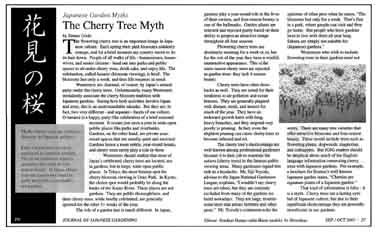|
The Cherry Blossom Tree
by Tamao Goda
MYTH: The cherry blossom tree is a common element in Japanese gardens.
FACT: Cherry trees are rarely employed in Japanese gardens. This is for numerous reasons, including their lack of four-season beauty. In Japan, cherry trees are commonly found in parks and public promenades, not gardens.
 The flowering cherry blossom tree is an important image in
Japanese culture. Each spring their pink blossoms suddenly
emerge, and for a brief moment my country seems to let its hair down. People
of all walks of life - businessmen, housewives, and senior citizens - head
out into parks and public spaces to sit under cherry trees, drink sake, and
enjoy life. The celebration, called hanami (blossom viewing), is brief. The
blossoms last only a week, and then life resumes as usual.
The flowering cherry blossom tree is an important image in
Japanese culture. Each spring their pink blossoms suddenly
emerge, and for a brief moment my country seems to let its hair down. People
of all walks of life - businessmen, housewives, and senior citizens - head
out into parks and public spaces to sit under cherry trees, drink sake, and
enjoy life. The celebration, called hanami (blossom viewing), is brief. The
blossoms last only a week, and then life resumes as usual.
Westerners are charmed, of course, by Japan’s annual party under the cherry trees. Unfortunately, many Westerners mistakenly associate the cherry blossom tradition with Japanese gardens. Seeing how both activities involve Japan and trees, this is an understandable mistake. But they are, in fact, two very different - and separate - facets of our culture. O-hanami is a happy, party-like celebration of a brief seasonal moment. It occurs just once a year in wide-open public places like parks and riverbanks. Gardens, on the other hand, are private year-round spaces that are usually quiet and enclosed. Gardens honor a more subtle, year-round beauty, and cherry trees rarely play a role in them.
Westerners should realize that most of Japan’s celebrated cherry blossom trees are located, not in gardens, but in large, wide-open public places. In Tokyo, the most famous spot for cherry blossom viewing is Ueno Park. In Kyoto, the choice spot would probably be along the banks of the Kamo River. These places are not gardens. They are public thoroughfares, and their cherry trees, while briefly celebrated, are generally ignored for the other 51 weeks of the year.
The role of a garden tree is much different. In Japan, gardens play a year-round role in the lives of their owners, and four-season beauty is one of the hallmarks. Garden plants are selected and rejected partly based on their ability to project an attractive image throughout all four seasons.
Flowering cherry trees are absolutely stunning for a week or so, but for
the rest of the year they have a woeful, unattractive appearance. This is
the main reason cherry trees are rejected as garden trees: they lack
4-season beauty. Cherry trees have other drawbacks as well. They are
noted for their weakness to air pollution and ocean breezes. They are
generally plagued with disease, mold, and insects for much of the year. They
have an awkward growth habit with long, heavy branches, and they respond
very poorly to pruning. In fact, even the
slightest pruning can cause cherry trees to become infected and rot.
The cherry tree’s shortcomings are well-known among professional
gardeners because it is their job to maintain the sakura (cherry trees) in
the famous public viewing areas. Many gardeners regard this task as a
headache. Mr. Eiji Toyoda, advisor to the Japan National Gardeners League,
explains, “I wouldn’t say cherry trees are taboo, but they are certainly
excluded from many of the gardens we build nowadays. They are large,
troublesome trees that attract termites and other pests.” Mr. Toyoda’s
comments echo the opinions of other pros when he states, “The blossoms last
only for a week. That’s fine in a park, where people can visit and then go
home. But people who have gardens have to live with them all year long.
Sakura are simply not suitable for
(Japanese) gardens.”
Westerners who wish to include flowering trees in their gardens need not worry. There are many tree varieties that offer attractive blossoms and four-season beauty. These would include trees such as flowering plums, dogwoods, magnolias, and crabapples. But JOJG readers should be skeptical about much of the English-language information connecting cherry trees with Japanese gardens. For example, a brochure for the Boston Museum of Fine Art's well-known Japanese garden states, “Cherries are signature plants of a Japanese garden.”
That kind of information is false - it is a myth. The cherry blossom tree is a lasting symbol of Japanese culture, but due to its significant shortcomings it is generally unwelcome in our gardens.